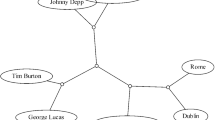Abstract
Clustering a data array has been found useful in the design of web-sites and distributed database system. We show that a critical step during this clustering process is related to solving the Longest Hamiltonian Path Problem, a well known NP-complete problem. Using the grouping of visitation paths of web-users as a case study, we test several heuristic algorithms. As a result of our experiments, we identify a successful method for dealing with this problem. Our algorithm spends less CPU time and provides better quality solutions than the most recent approach.















Similar content being viewed by others
References
McCormick Jr WT, Schweitzer PJ and White TW (1972). Problem decomposition and data reorganization by a clustering technique. Opns Res 20: 993–1009.
Chinchwadkar GS and Goh A (1999). An overview of vertical partitioning in object oriented databases. Comput J 42: 39–50.
Lin X, Orlowska M and Zhang Y (1993). A graph based cluster approach for vertical partitioning in database design. Data Knowl Engng 11: 151–169.
Özsu MT and Valduriez P (1999). Principles of Distributed Database Systems, 2nd edn. Prentice-Hall: Englewood Cliffs, NJ.
Xiao J, Zhang Y, Jia X and Li T (2001). Measuring similarity of interests for clustering web-users. In: Orlowska ME and Roddick JR (eds). Australian Computer Science Communications. Database Technologies, Proceedings of the 12th Australasian Database Conference ADC 2001, Vol 23. IEEE Computer Society: Silver Spring, MD, pp 107–114.
Amirahnadi F and Choobineh F (1996). Identifying the composition of a cellular manufacturing system. Int J Prod Res 34: 2471–2488.
Askin RG, Cresswell SH, Golberd JB and Vakharia AJ (1991). A Hamiltonian Path approach to reordering the part-machine matrix for cellular manufacturing. Int J Prod Res 29: 1081–1100.
Boctor FF (1996). The minimum-cost, machine-part cell formation problem. Int J Prod Res 34: 1045–1063.
Lozano S, Adenso-Díaz B, Eguia I and Oniseva L (1999). A one-step tabu search algorithm for manufacturing cell design. J Opl Res Soc 50: 509–516.
Sarker BR and Li Z (1998). Measuring matrix-based cell formation with alternative routings. J Opl Res Soc 49: 953–965.
Hochbaum DS (ed) (1997). Approximation Algorithms for NP-Hard Problems. PWS Publishing Company: Boston, MA.
Perkowitz M and Etzioni O (1998). Adaptive web sites: Automatically synthesizing web pages. In: Proceedings of the 15th National Conference on Artificial Intelligence, Madison, WI, July 1998 American Association for Artificial Intelligence. AAAI Press, pp 727–732.
Doyle J (1994). Clumping data in 2-way tables: a user-oriented perspective. J Opl Res Soc 45: 203–213.
Harhalakis G, Lu T, Minis I and Nagi R (1996). A practical method for design of hybrid-type production facilities. Int J Prod Res 34: 897–918.
Cheng C-H (1995). A branch and bound clustering algorithm. IEEE Trans Systems Man Cybern 25: 895–898.
Veeramani D and Mani K (1996). A polynomial-time algorithm for optimal clustering in a special class of 0,1-matrices. Int J Prod Res 34: 2587–2611.
Ng SM (1991). Bond energy, rectilinear distance and a worst-case bound for the group technology problem. J Opl Res Soc 42: 571–578.
Aarts E and Lenstra JK (1997). Introduction. In: Aarts E and Lenstra JK (eds) Local Search in Combinatorial Optimization. John Wiley & Sons, New York, pp 1–17.
Croes GA (1958). A method for solving traveling-salesman problems. Opns Res 5: 791–812.
Garey MR and Johnson DS (1979). Computers and Intractability. A Guide to the Theory of NP-Completeness. WH Freeman and Company: New York.
Garfinkel RS (1985). Motivation and modelling. In: Lawler EL, Lenstra JK, Rinnooy Kan AHG and Shmoys DB (eds). The Traveling Salesman Problem. John Wiley & Sons, New York, pp 17–36.
Lawler EL, Lenstra JK, Rinnooy Kan AHG and Shmoys DB (eds) (1985). The Traveling Salesman Problem. John Wiley & Sons, New York.
Lenstra JK (1974). Clustering a data array and the traveling-salesman problem. Opns Res 22: 413–414.
Fredman ML, Johnson DS, McGeoch LA and Ostheimer G (1995). Data structures for traveling salesmen. J Algorithms 18: 432–479.
Lin S and Kernighan BW (1973). An effective heuristic for the traveling- salesman problem. Opns Res 21: 498–516.
Johnson DS and McGeoch LA (1997). The traveling salesman problem: a case study. In: E Aarts and JK Lenstra (eds). Local Search in Combinatorial Optimization. John Wiley & Sons, New York, pp 215–310.
Kindervater GAP and Savelsbergh MWP (1997). Vehicle routing: handling edge exchanges. In: E Aarts and JK Lenstra (eds). Local Search in Combinatorial Optimization. John Wiley & sons, New York, pp 337, 360.
Chandra B, Karloff H and Tovey C (1999). New results on the old k-opt algorithm for the traveling salesman problem. SIAM J Comput 28: 1998–2029.
Author information
Authors and Affiliations
Corresponding author
Rights and permissions
About this article
Cite this article
Torres-Velázquez, R., Estivill-Castro, V. Local search for Hamiltonian Path with applications to clustering visitation paths. J Oper Res Soc 55, 737–748 (2004). https://doi.org/10.1057/palgrave.jors.2601770
Received:
Accepted:
Published:
Issue Date:
DOI: https://doi.org/10.1057/palgrave.jors.2601770




